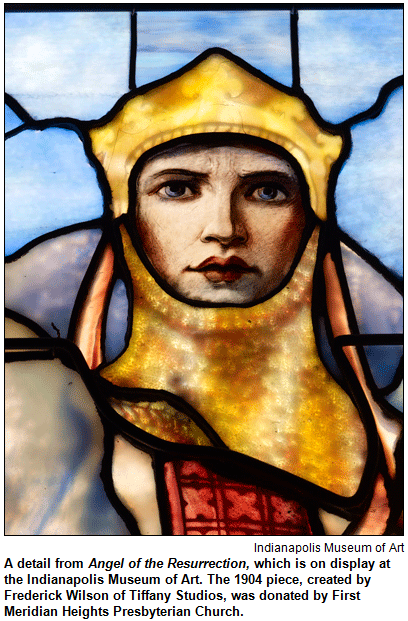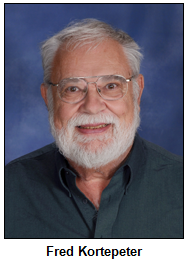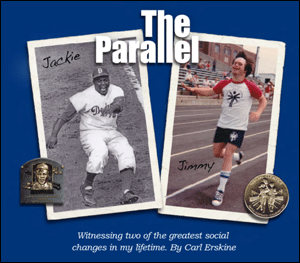April 5 show
Tiffany windows across Indiana
 One of them - titled the Angel of the Resurrection and informally known as the "President Benjamin Harrison Memorial Window" - is at the Indianapolis Museum of Art.
One of them - titled the Angel of the Resurrection and informally known as the "President Benjamin Harrison Memorial Window" - is at the Indianapolis Museum of Art.
Another, The Ascension with Passion Flower and Vine, is in the chancel of Second Presbyterian Church in Indianapolis.
And other stained glass windows created in the late 1800s or early 1900s by the iconic, New York-based Tiffany Studios are in the Episcopal Cathedral of St. James in South Bend; the Morrison-Reeves Library in Richmond and on various mausoleums across Indiana.
As Hoosier History Live! explores those stunning Tiffany windows and others across Indiana, Nelson will be joined in studio by two guests:
- Leslie Anderson-Perkins, a curatorial assistant at the IMA, which is about to launch a small exhibit associated with the "Harrison Window," which was commissioned by the former president's second wife and widow, Mary Lord Harrison, after his death in 1901. The window, which depicts Michael, the angel of the resurrection, signaling the dead to rise with the second coming of Christ, originally was installed at the former First Presbyterian Church, where Benjamin Harrison had been an elder for more than 40 years. More details recently have surfaced about the early history of the window.
- And Fred Kortepeter, the historian at Second Presbyterian Church. Its Tiffany window, which is 25-by-12 feet, was installed in the early 1900s when the church was located at Vermont and Pennsylvania streets. The massive window was re-installed when the church moved in the late 1950s to the current site at 7700 N. Meridian Street.
 From the late 1870s through the early 1930s, Louis Comfort Tiffany and his decorative glass company (which had various names, but primarily was known as Tiffany Studios) produced thousands of windows for churches, businesses, private homes and mausoleums across the country.
From the late 1870s through the early 1930s, Louis Comfort Tiffany and his decorative glass company (which had various names, but primarily was known as Tiffany Studios) produced thousands of windows for churches, businesses, private homes and mausoleums across the country.
Wherever their location, Tiffany windows almost always are eye-catching, to say the least. Typically, the stained glass is multicolored and, during sunlight, has an iridescent effect; vibrant mottled glass is a hallmark of many of the windows.
 Declaring his life's goal was the "pursuit of beauty," Louis Comfort Tiffany (1848-1933) oversaw many designers at his decorative glass business. His father, Charles Lewis Tiffany, had founded the luxury jewelry retailer known as Tiffany & Co.
Declaring his life's goal was the "pursuit of beauty," Louis Comfort Tiffany (1848-1933) oversaw many designers at his decorative glass business. His father, Charles Lewis Tiffany, had founded the luxury jewelry retailer known as Tiffany & Co.
Leslie, our guest from the IMA, has traveled to South Bend and Richmond to gather details about the Tiffany windows in those Hoosier cities. In addition to the library in Richmond, buildings in the far-eastern Indiana city with Tiffany windows include St. Paul's Episcopal Church and Reid Memorial Church, a Presbyterian congregation that commissioned several stained-glass windows.
 In Indianapolis, the same Tiffany artist, Frederick Wilson, designed the windows for both First and Second Presbyterian churches. Wilson, who often signed his windows, was one of the best-known designers at Tiffany, where many others worked in near-obscurity, overshadowed by the legendary "Tiffany" name.
In Indianapolis, the same Tiffany artist, Frederick Wilson, designed the windows for both First and Second Presbyterian churches. Wilson, who often signed his windows, was one of the best-known designers at Tiffany, where many others worked in near-obscurity, overshadowed by the legendary "Tiffany" name.
After various congregational changes and moves involving First Presbyterian Church, the Angel of the Resurrection window was donated in the early 1970s to the IMA by First Meridian Heights Presbyterian Church, a successor to the congregation. The window depicts Michael, the heroic angel, wearing chain mail and resembling a medieval knight as he beckons the dead to rise.
 The Benjamin Harrison Presidential Site has provided the IMA with a presentation sketch for the window that was given to Mrs. Harrison; the sketch, along with a Tiffany Studios catalogue, will be displayed with the window as part of the exhibit.
The Benjamin Harrison Presidential Site has provided the IMA with a presentation sketch for the window that was given to Mrs. Harrison; the sketch, along with a Tiffany Studios catalogue, will be displayed with the window as part of the exhibit.
At Second Presbyterian, the Tiffany window was a gift to the church by the widow of a congregant, Charles F. Sayles, who died in 1902. The Ascension with Passion Flower and Vine initially was installed in 1905, according to a timeline supplied by our guest Fred Kortepeter.
Fred also has a list of Tiffany windows that had been installed - or were being commissioned - across Indiana circa 1910. The current whereabouts of some of the Tiffany windows has been a bit of a mystery. Both of our guests have undertaken research to explain about what may happened to some of the windows.
Some history facts:
- Among the predecessors of Benjamin Harrison, who served as president from 1888 to 1892, was Chester A. Arthur. He commissioned a young Louis C. Tiffany to decorate several rooms of the White House, boosting Tiffany's career.
- Benjamin Harrison's first wife, Caroline Scott Harrison, died of tuberculosis while she was the nation's first lady. After his defeat for re-election in 1892, Harrison returned to Indianapolis, resumed his law practice and married Mary Lord. Their daughter was a young child when her father died.
- In South Bend, the Cathedral of St. James actually has four Tiffany windows. One of the stained glass windows at the Episcopal church was a gift from the family of Peter Studebaker, who was among the five Studebaker Brothers of wagon- and car-making fame. This window initially was displayed at the 1893 Chicago World's Fair.
"Learn more" videos:
History Mystery
 Major glass sculptures created by Dale Chihuly, the famous contemporary artist, have been commissioned across Indiana. And there have been exhibits of Chihuly's sculptures of blown glass at the Fort Wayne Museum of Art and many other cultural sites in the Hoosier state. The Children's Museum of Indianapolis features "Fireworks of Glass," a 43-foot tower that's considered to be the largest permanent sculpture of blown glass created by Chihuly, who is based in the state of Washington.
Major glass sculptures created by Dale Chihuly, the famous contemporary artist, have been commissioned across Indiana. And there have been exhibits of Chihuly's sculptures of blown glass at the Fort Wayne Museum of Art and many other cultural sites in the Hoosier state. The Children's Museum of Indianapolis features "Fireworks of Glass," a 43-foot tower that's considered to be the largest permanent sculpture of blown glass created by Chihuly, who is based in the state of Washington.
Elsewhere in Indianapolis, the Indiana University School of Medicine commissioned an enormous sculpture by Chihuly that represents an aspect of human biology. The glass sculpture, which weighs 3,000 pounds, was dedicated in 2003 in the medical school complex on the IUPUI campus.
Question: What aspect of biology does the massive sculpture symbolize?
The call-in number is (317) 788-3314. Please do not call into the show until you hear Nelson pose the question on the air, and please do not try to win the prize if you have won any other prize on WICR during the last two months.
The prize is a gift certificate to Arni's Restaurant and two admission to the Latitude 360 entertainment center in Castleton, courtesy of Visit Indy.
Roadtrip: Chief Richardville House in Fort Wayne
 Guest Roadtripper Tom Castaldi of Fort Wayne suggests a visit to the only known standing Treaty House in America, the Chief Richardville House in Fort Wayne. On the city's southwest side at 5705 Bluffton Road, the house is in the Greek Revival style and was built in 1827 for Miami Indian Civil Chief Jean-Baptiste de Richardville.
Guest Roadtripper Tom Castaldi of Fort Wayne suggests a visit to the only known standing Treaty House in America, the Chief Richardville House in Fort Wayne. On the city's southwest side at 5705 Bluffton Road, the house is in the Greek Revival style and was built in 1827 for Miami Indian Civil Chief Jean-Baptiste de Richardville.
A myth prevails that an unusually formed silver maple tree at the front entrance to the home has a special meaning in the Miami culture. Tom says that it cannot be determined whether the twisting of the limbs was caused by an act of nature or by human manipulation.
Within the lawn area of the house are two mature lilac trees that may be date to the 19th century. The house is open for touring each first Saturday between May and November. Admission is $7, or $5 for seniors or $3 for students.
Your Hoosier History Live! team,
Nelson Price, host and creative director
Molly Head, producer, (317) 927-9101
Richard Sullivan, webmaster and tech director
Pam Fraizer, graphic designer
Garry Chilluffo, creative consultant
Joan Hostetler, Michele Goodrich, Jed Duvall, Dana Waddell, advisors
www.hoosierhistorylive.org






Please tell our sponsors that you appreciate their support: Indiana Authors Award | Indiana Historical Society | Indiana Landmarks | Lucas Oil | Story Inn | The Fountain Square Theatre Building

 Acknowledgments to Monomedia, Visit Indy, WICR-FM, Fraizer Designs, Heritage Photo & Research Services, Derrick Lowhorn and many other individuals and organizations. We are an independently produced program and are self-supporting through organizational sponsorships and individual contributions. We do not receive any government funding. Visit our website to learn how you can support us financially. Also, see our Twitter feed and our Facebook page for regular updates.
Acknowledgments to Monomedia, Visit Indy, WICR-FM, Fraizer Designs, Heritage Photo & Research Services, Derrick Lowhorn and many other individuals and organizations. We are an independently produced program and are self-supporting through organizational sponsorships and individual contributions. We do not receive any government funding. Visit our website to learn how you can support us financially. Also, see our Twitter feed and our Facebook page for regular updates.
6th-anniversary party
Party photos!
Here are a few more photos from our lovely and well-attended 6th-anniversary soiree. The Feb. 27 event at Indiana Landmarks was attended by about 200 history lovers, including dozens of guests on the Hoosier History Live program.
April 12 show
Baseball great Carl Erskine of Anderson
With the season opening of Major League Baseball this week, Hoosier History Live! will explore the career as well as the life away from the dugout of one of the most beloved Hoosiers who ever pitched.
Nelson's special guest will be Anderson native Carl Erskine, a star pitcher for the Brooklyn Dodgers (he was chosen to pitch the opening game in 1958 when the Dodgers moved to Los Angeles) during the era that the team's roster included his longtime close friend Jackie Robinson, who broke the racial barrier in the major leagues. Carl Erskine pitched for the Dodgers in five World Series.
 After retiring from baseball, Carl, now 87, returned to Anderson and became one of the top business and civic leaders in his hometown.
After retiring from baseball, Carl, now 87, returned to Anderson and became one of the top business and civic leaders in his hometown.
Carl and his wife, Betty, have been particularly dedicated to Special Olympics, in which their son Jimmy, who has Down syndrome and is now in his 50s, continues to compete. Carl wrote his most recent book, The Parallel (2012), as a way to raise funds for Special Olympics Indiana. The book draws parallels between the evolving social acceptances of minorities - thanks to trailblazers like Jackie Robinson - and societal acceptance of people with disabilities. Carl's other books include What I Learned from Jackie Robinson (McGraw-Hill, 2005).
Carl met Jackie Robinson in 1948 when the Hoosier was playing in the minor leagues and the civil rights pioneer gave him encouragement in the dugout. Carl went on to win 122 games as a pitcher for the Brooklyn/Los Angeles Dodgers. He also pitched three two no-hitters during his 12-year career with the team. In 1953, he set a record in the World Series for striking out 14 players. (They were New York Yankees.)
Following his return to Anderson, where he started out in sandlot, high school and amateur baseball, Carl was a bank president for several years. He also coached the baseball team at Anderson University and, for more than 40 years, has volunteered for Special Olympics.
His honors include being named a Living Legend by the Indiana Historical Society in 1999 and, in 2010, receiving the Sachem Award from then-Gov. Mitch Daniels in a ceremony at the Indiana Statehouse.
© 2014 Hoosier History Live! All rights reserved.